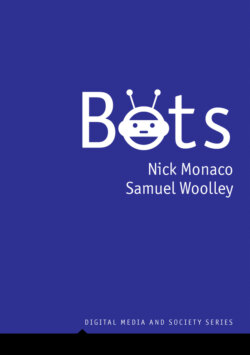Читать книгу Bots - Nick Monaco - Страница 18
Different Types of Bots
ОглавлениеOne problem with understanding bots is the term’s ambiguity: the word has several distinct (though often overlapping) meanings. This makes it particularly difficult for policymakers trying to write sensible technology legislation. Indeed, in the words of two communications scholars, the “multiple forms of ambiguity are responsible for much of the complexity underlying contemporary bot policy” (Gorwa & Guilbeault, 2018).
People have been trying to define what bots are since the 1990s, and multiple bot “typologies” have been proposed by journalists, researchers, and academic experts seeking to organize and categorize the profusion of different bots. These typologies vary from informal groupings to more formal taxonomies (Gorwa & Guilbeault, 2018; Leonard, 1997; Maus, 2017; Stieglitz et al., 2017), and some limit themselves to specific subtypes of bots, such as news bots or political bots (DiResta et al., 2017; Lokot & Diakopoulos, 2016). However, the rapid pace of bot evolution means that these taxonomies can quickly break or become out-of-date. Nonetheless, these efforts are extremely important and provide us with footholds with which to navigate the nascent and ever-evolving landscape of bots and their uses, capabilities, and characteristics.
Recognizing the rapidly changing landscape in bot and disinformation research, the bot categories we discuss here are the most important ones at the time we are writing this book. These categories have largely remained relevant for understanding and analyzing bot behavior in the past three decades. This is not an exhaustive list, but it is a useful introduction to the field. Armed with these categories, the reader will be able to grasp modern bots’ main uses in the political, social, commercial worlds.
